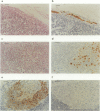Abstract
Although the presence of axillary node metastases in breast cancer is a key prognostic indicator and may influence treatment decisions, a significant proportion of patients diagnosed as axillary node negative (ANN) using standard histopathological techniques may have occult nodal metastases (OMs). A combination of limited step-sectioning (4 x 100 microns intervals) and immunohistochemical staining (with cytokeratin (MNF.116) and MUC1 (BC2) antibodies) was used to detect OM in a retrospective series of 208 ANN patients. OMs were found in 53 patients (25%), and both step-sectioning and immunohistochemical detection significantly improved detection (P < 0.05). Detection using BC2 (25%) was superior to MNF.116 (18%) and haematoxylin and eosin (H&E) (8%). OMs were found in 51 patients using only the first and deepest sectioning levels and BC2 staining. OMs were more frequently found in lobular (38%) than ductal carcinoma (25%), and more frequently in women less than 50 years (41%) than in older women (19%). Univariate overall and disease-free survival analyses showed that the presence, size and number of OM had prognostic significance as did tumour size (disease-free only) and histological and nuclear grade (P > 0.05). Cox multivariate proportional hazard regression analyses showed that the presence and increasing size of OMs were significantly associated with poorer disease-free survival, independently of other prognostic factors (P < 0.05). However there was not a significant independent association of the presence of occult metastases with overall survival (P = 0.11). These findings have important implications with regard to selection of ANN patients for adjuvant therapy.
Full text
PDF
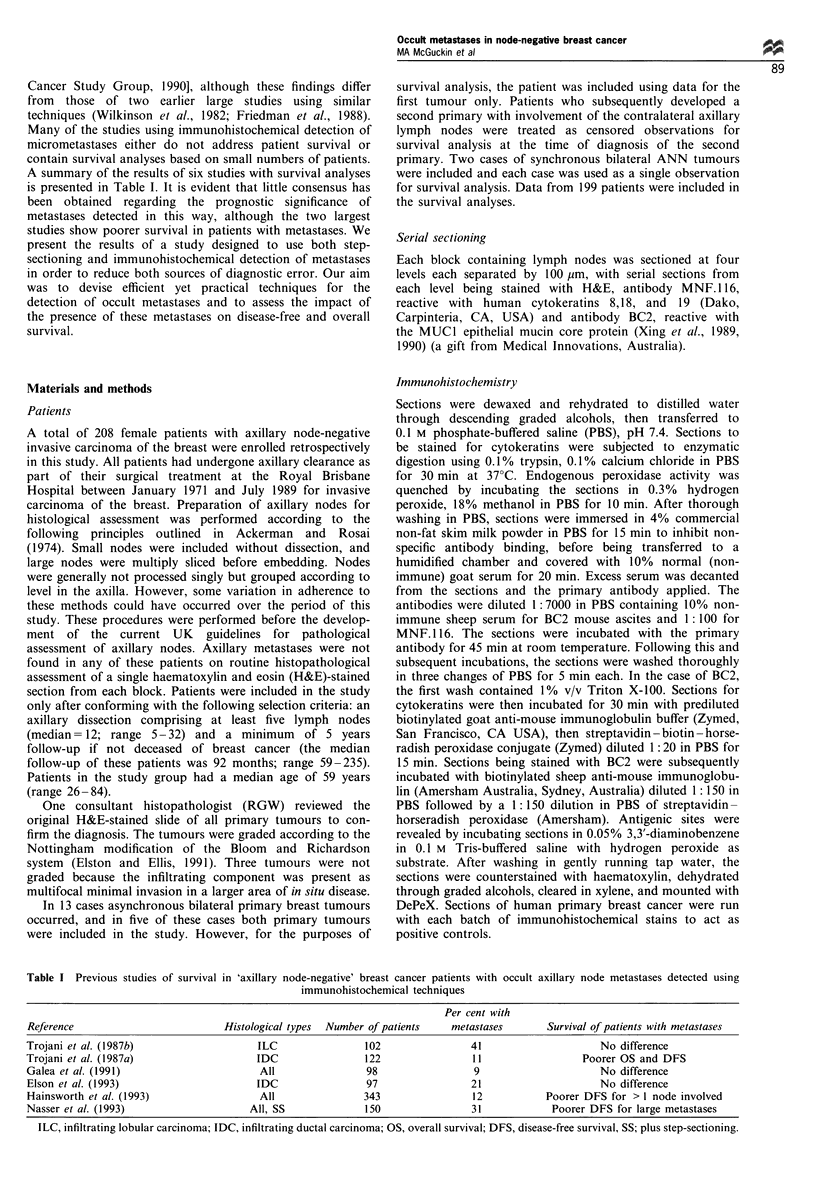
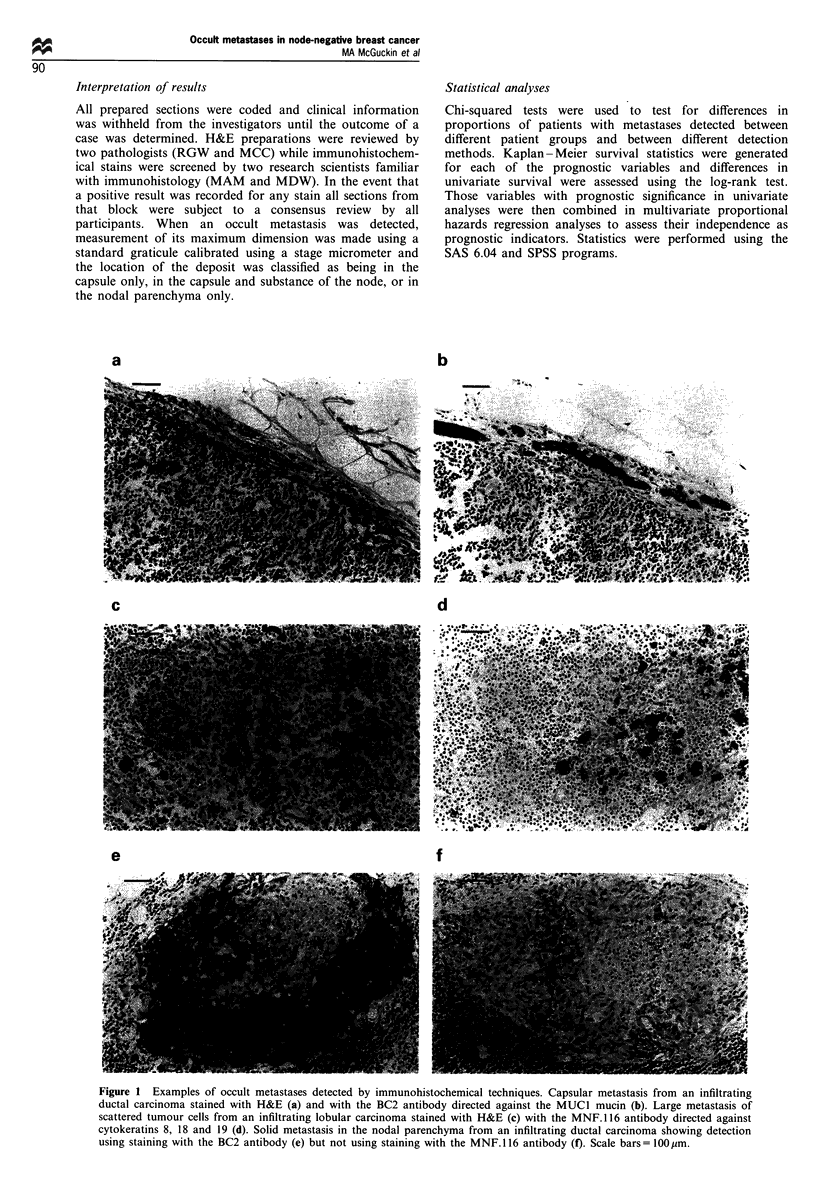
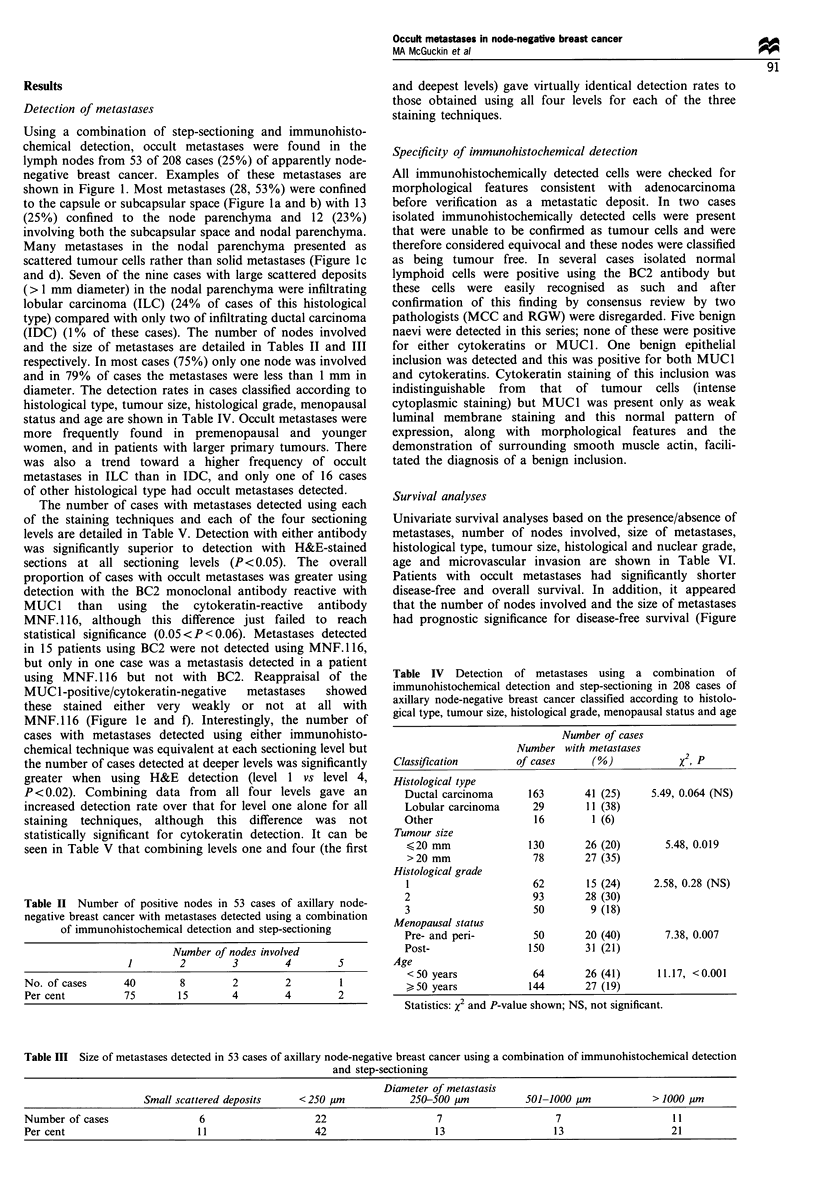

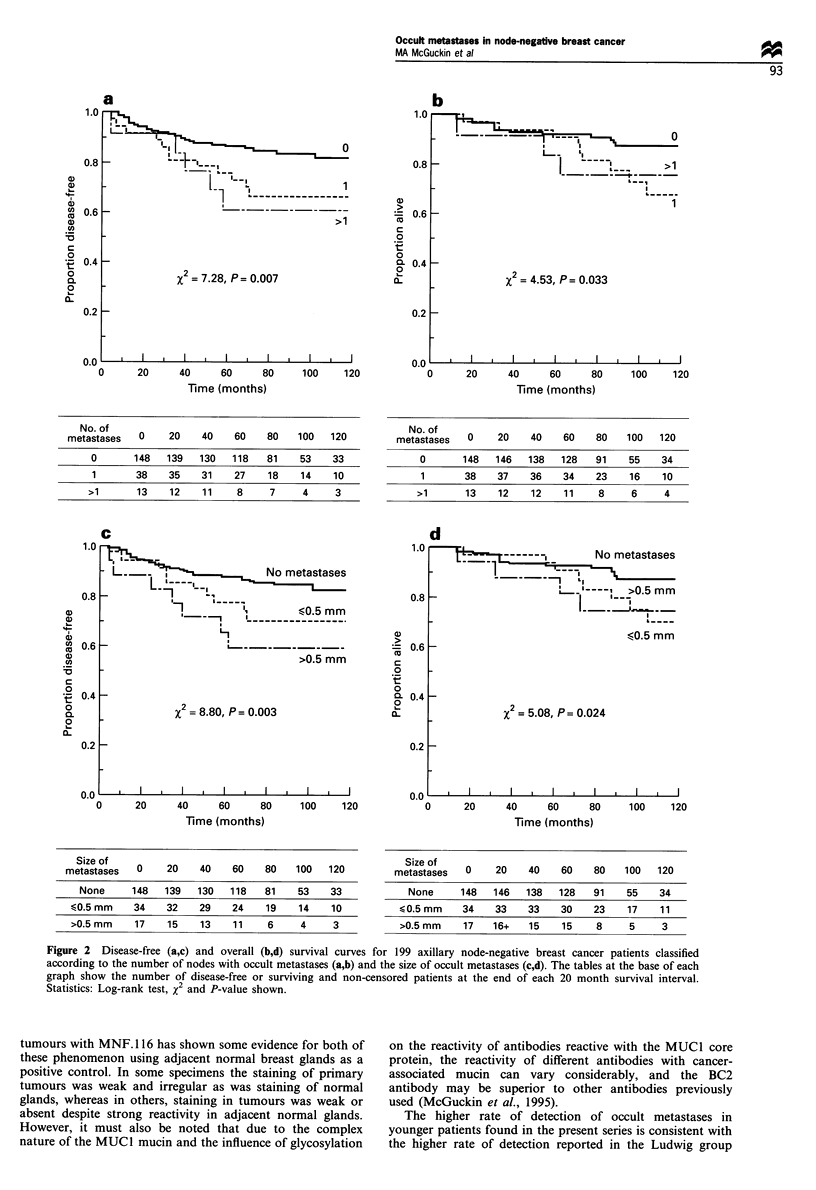
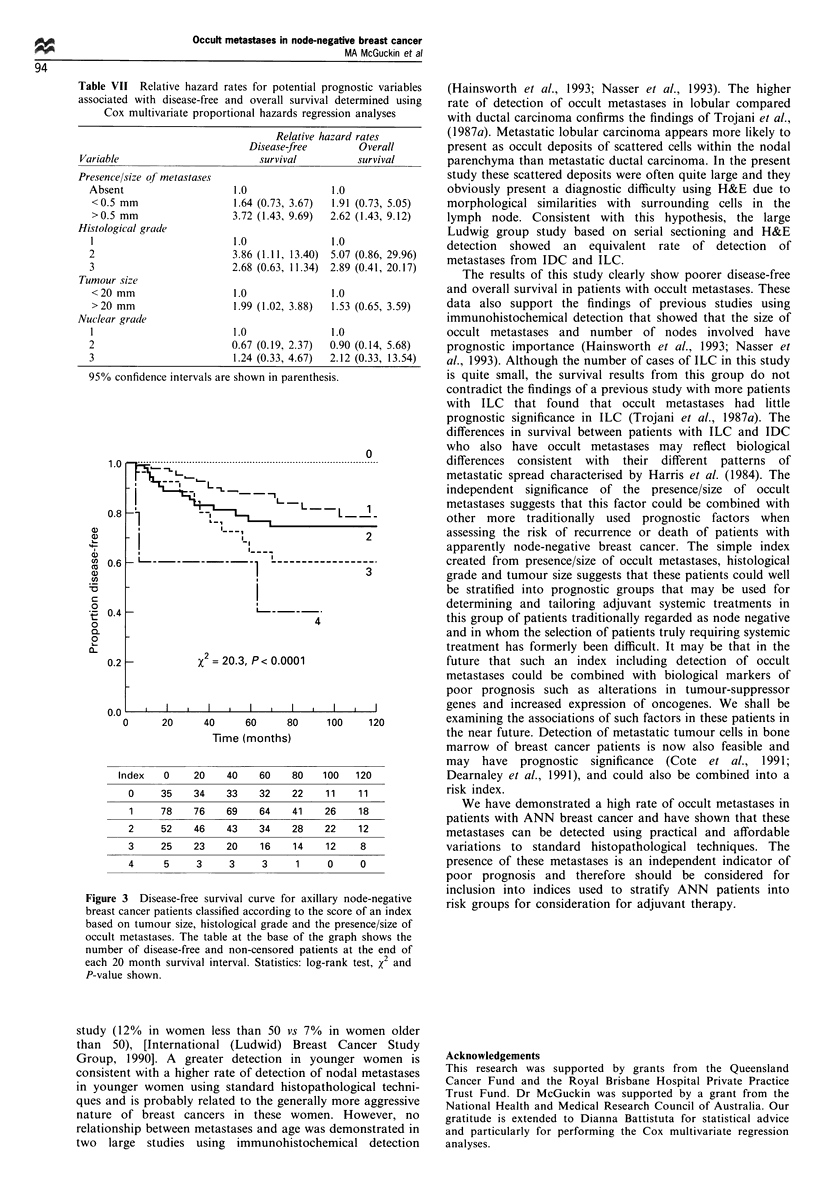
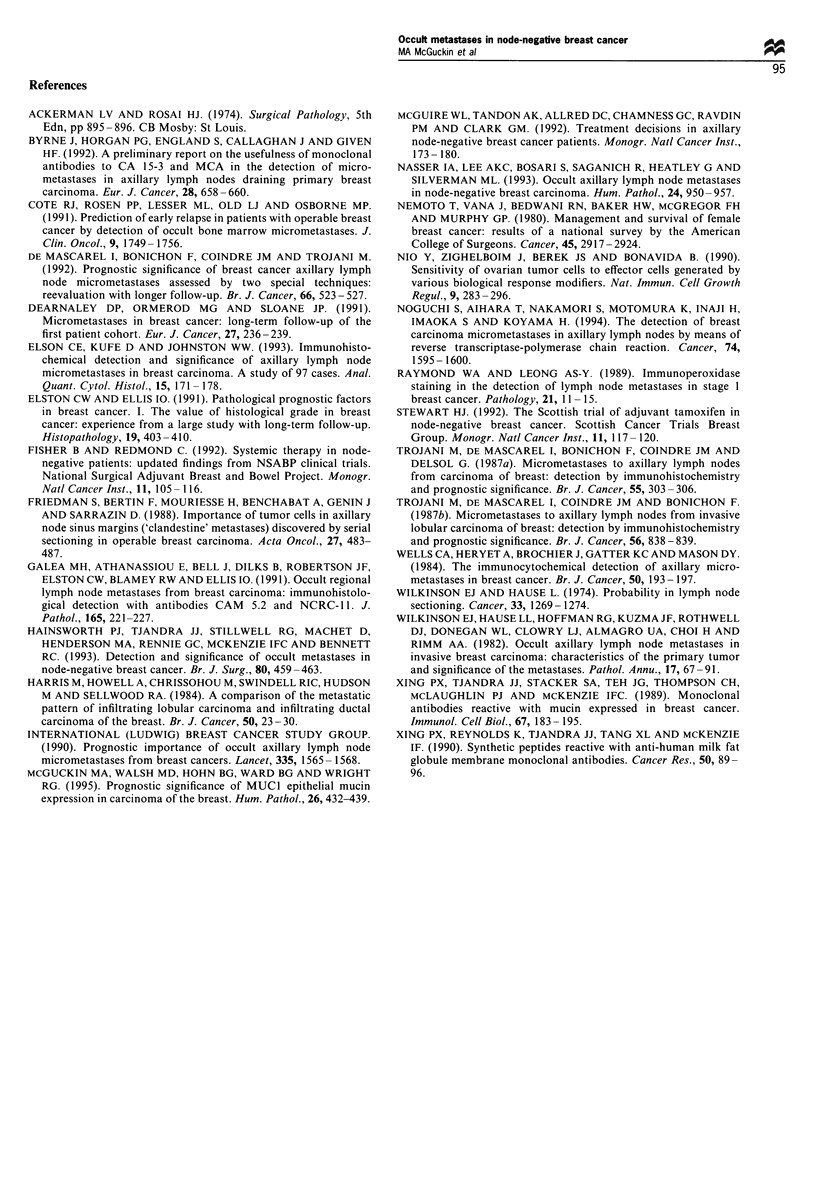
Images in this article
Selected References
These references are in PubMed. This may not be the complete list of references from this article.
- Byrne J., Horgan P. G., England S., Callaghan J., Given H. F. A preliminary report on the usefulness of monoclonal antibodies to CA 15-3 and MCA in the detection of micrometastases in axillary lymph nodes draining primary breast carcinoma. Eur J Cancer. 1992;28(2-3):658–660. doi: 10.1016/s0959-8049(05)80120-0. [DOI] [PubMed] [Google Scholar]
- Cote R. J., Rosen P. P., Lesser M. L., Old L. J., Osborne M. P. Prediction of early relapse in patients with operable breast cancer by detection of occult bone marrow micrometastases. J Clin Oncol. 1991 Oct;9(10):1749–1756. doi: 10.1200/JCO.1991.9.10.1749. [DOI] [PubMed] [Google Scholar]
- Dearnaley D. P., Ormerod M. G., Sloane J. P. Micrometastases in breast cancer: long-term follow-up of the first patient cohort. Eur J Cancer. 1991;27(3):236–239. doi: 10.1016/0277-5379(91)90504-7. [DOI] [PubMed] [Google Scholar]
- Elson C. E., Kufe D., Johnston W. W. Immunohistochemical detection and significance of axillary lymph node micrometastases in breast carcinoma. A study of 97 cases. Anal Quant Cytol Histol. 1993 Jun;15(3):171–178. [PubMed] [Google Scholar]
- Elston C. W., Ellis I. O. Pathological prognostic factors in breast cancer. I. The value of histological grade in breast cancer: experience from a large study with long-term follow-up. Histopathology. 1991 Nov;19(5):403–410. doi: 10.1111/j.1365-2559.1991.tb00229.x. [DOI] [PubMed] [Google Scholar]
- Fisher B., Redmond C. Systemic therapy in node-negative patients: updated findings from NSABP clinical trials. National Surgical Adjuvant Breast and Bowel Project. J Natl Cancer Inst Monogr. 1992;(11):105–116. [PubMed] [Google Scholar]
- Friedman S., Bertin F., Mouriesse H., Benchabat A., Genin J., Sarrazin D., Contesso G. Importance of tumor cells in axillary node sinus margins ('clandestine' metastases) discovered by serial sectioning in operable breast carcinoma. Acta Oncol. 1988;27(5):483–487. doi: 10.3109/02841868809093575. [DOI] [PubMed] [Google Scholar]
- Galea M. H., Athanassiou E., Bell J., Dilks B., Robertson J. F., Elston C. W., Blamey R. W., Ellis I. O. Occult regional lymph node metastases from breast carcinoma: immunohistological detection with antibodies CAM 5.2 and NCRC-11. J Pathol. 1991 Nov;165(3):221–227. doi: 10.1002/path.1711650305. [DOI] [PubMed] [Google Scholar]
- Hainsworth P. J., Tjandra J. J., Stillwell R. G., Machet D., Henderson M. A., Rennie G. C., McKenzie I. F., Bennett R. C. Detection and significance of occult metastases in node-negative breast cancer. Br J Surg. 1993 Apr;80(4):459–463. doi: 10.1002/bjs.1800800417. [DOI] [PubMed] [Google Scholar]
- Harris M., Howell A., Chrissohou M., Swindell R. I., Hudson M., Sellwood R. A. A comparison of the metastatic pattern of infiltrating lobular carcinoma and infiltrating duct carcinoma of the breast. Br J Cancer. 1984 Jul;50(1):23–30. doi: 10.1038/bjc.1984.135. [DOI] [PMC free article] [PubMed] [Google Scholar]
- McGuckin M. A., Walsh M. D., Hohn B. G., Ward B. G., Wright R. G. Prognostic significance of MUC1 epithelial mucin expression in breast cancer. Hum Pathol. 1995 Apr;26(4):432–439. doi: 10.1016/0046-8177(95)90146-9. [DOI] [PubMed] [Google Scholar]
- McGuire W. L., Tandon A. K., Allred D. C., Chamness G. C., Ravdin P. M., Clark G. M. Treatment decisions in axillary node-negative breast cancer patients. J Natl Cancer Inst Monogr. 1992;(11):173–180. [PubMed] [Google Scholar]
- Nasser I. A., Lee A. K., Bosari S., Saganich R., Heatley G., Silverman M. L. Occult axillary lymph node metastases in "node-negative" breast carcinoma. Hum Pathol. 1993 Sep;24(9):950–957. doi: 10.1016/0046-8177(93)90108-s. [DOI] [PubMed] [Google Scholar]
- Nemoto T., Vana J., Bedwani R. N., Baker H. W., McGregor F. H., Murphy G. P. Management and survival of female breast cancer: results of a national survey by the American College of Surgeons. Cancer. 1980 Jun 15;45(12):2917–2924. doi: 10.1002/1097-0142(19800615)45:12<2917::aid-cncr2820451203>3.0.co;2-m. [DOI] [PubMed] [Google Scholar]
- Nio Y., Zighelboim J., Berek J. S., Bonavida B. Sensitivity of ovarian tumor cells to effector cells generated by various biological response modifiers. Nat Immun Cell Growth Regul. 1990;9(4):283–296. [PubMed] [Google Scholar]
- Noguchi S., Aihara T., Nakamori S., Motomura K., Inaji H., Imaoka S., Koyama H. The detection of breast carcinoma micrometastases in axillary lymph nodes by means of reverse transcriptase-polymerase chain reaction. Cancer. 1994 Sep 1;74(5):1595–1600. doi: 10.1002/1097-0142(19940901)74:5<1595::aid-cncr2820740516>3.0.co;2-l. [DOI] [PubMed] [Google Scholar]
- Raymond W. A., Leong A. S. Immunoperoxidase staining in the detection of lymph node metastases in stage I breast cancer. Pathology. 1989 Jan;21(1):11–15. doi: 10.3109/00313028909059522. [DOI] [PubMed] [Google Scholar]
- Stewart H. J. The Scottish trial of adjuvant tamoxifen in node-negative breast cancer. Scottish Cancer Trials Breast Group. J Natl Cancer Inst Monogr. 1992;(11):117–120. [PubMed] [Google Scholar]
- Trojani M., de Mascarel I., Bonichon F., Coindre J. M., Delsol G. Micrometastases to axillary lymph nodes from carcinoma of breast: detection by immunohistochemistry and prognostic significance. Br J Cancer. 1987 Mar;55(3):303–306. doi: 10.1038/bjc.1987.59. [DOI] [PMC free article] [PubMed] [Google Scholar]
- Trojani M., de Mascarel I., Coindre J. M., Bonichon F. Micrometastases to axillary lymph nodes from invasive lobular carcinoma of breast: detection by immunohistochemistry and prognostic significance. Br J Cancer. 1987 Dec;56(6):838–839. doi: 10.1038/bjc.1987.301. [DOI] [PMC free article] [PubMed] [Google Scholar]
- Wells C. A., Heryet A., Brochier J., Gatter K. C., Mason D. Y. The immunocytochemical detection of axillary micrometastases in breast cancer. Br J Cancer. 1984 Aug;50(2):193–197. doi: 10.1038/bjc.1984.162. [DOI] [PMC free article] [PubMed] [Google Scholar]
- Wilkinson E. J., Hause L. L., Hoffman R. G., Kuzma J. F., Rothwell D. J., Donegan W. L., Clowry L. J., Almagro U. A., Choi H., Rimm A. A. Occult axillary lymph node metastases in invasive breast carcinoma: characteristics of the primary tumor and significance of the metastases. Pathol Annu. 1982;17(Pt 2):67–91. [PubMed] [Google Scholar]
- Wilkinson E. J., Hause L. Probability in lymph node sectioning. Cancer. 1974 May;33(5):1269–1274. doi: 10.1002/1097-0142(197405)33:5<1269::aid-cncr2820330512>3.0.co;2-x. [DOI] [PubMed] [Google Scholar]
- Xing P. X., Reynolds K., Tjandra J. J., Tang X. L., McKenzie I. F. Synthetic peptides reactive with anti-human milk fat globule membrane monoclonal antibodies. Cancer Res. 1990 Jan 1;50(1):89–96. [PubMed] [Google Scholar]
- Xing P. X., Tjandra J. J., Stacker S. A., Teh J. G., Thompson C. H., McLaughlin P. J., McKenzie I. F. Monoclonal antibodies reactive with mucin expressed in breast cancer. Immunol Cell Biol. 1989 Jun;67(Pt 3):183–195. doi: 10.1038/icb.1989.29. [DOI] [PubMed] [Google Scholar]
- de Mascarel I., Bonichon F., Coindre J. M., Trojani M. Prognostic significance of breast cancer axillary lymph node micrometastases assessed by two special techniques: reevaluation with longer follow-up. Br J Cancer. 1992 Sep;66(3):523–527. doi: 10.1038/bjc.1992.306. [DOI] [PMC free article] [PubMed] [Google Scholar]



